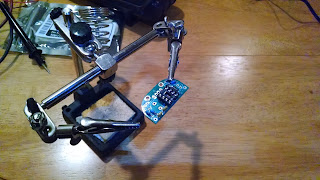Happy holidays!
This Christmas, my brother-in-law gave me the best gift: a MintyBoost v3.0 construction kit
Unboxing
In addition to the kit itself (and Altoids tin---Altoids included!), I received a new soldering iron and stand, small flat-Philips screwdriver, and desoldering braid. This would be a good starting kit for anyone interested in getting their hands dirty (for someone who has no tools, I'd also include a multimeter and tin snips; a table clamp would also never go amiss, and decrease the odds of singeing your table working on a project).
and tin snips; a table clamp would also never go amiss, and decrease the odds of singeing your table working on a project).
 |
| Unboxed. Android with Santa hat and napkins not included. |
Assembly
 |
| Altoids tin is not included with the project, but Nick provided me one. It came pre-filled! :) |
The MintyBoost took me about three hours to fully assemble, from opening the box to testing charge. This was a fast project (especially compared to the interminable 3D Cube project).
 |
| Mid-assembly; almost all components soldered on. |
I'd definitely recommend this project as a beginner's kit, though possibly not a first kit (depending on your user's level of comfort with soldering and small parts). Not only does it cover a decent set of skills (soldering to circuit board, identifying components, modifying a case), the instructions are really excellent and detailed, willing to throw at least a sentence of explanation into every component on the board. Would that all guides bothered with this level of detail! To be honest, I have almost nothing to add beyond what those will tell you in terms of component assembly.
 |
| Fully assembled and installed. There is plenty of room in there. |
In terms of assembling the case: the Altoids gum tin that the project was originally designed for is no longer around, but it fits perfectly fine in the slightly larger Altoids mint tin form-factor. In fact, the larger form-factor means that there's room for a third battery in there if you're inclined to swap out the shipped 2-battery clip for a 3-battery clip. The documentation on batteries and the MintyBoost notes that 3 in series is probably fine, though 4 is inadvisable (your voltage will exceed 5 volts, which will be unhealthy for the MintyBoost's regulator electronics). I didn't mod in that direction, so your mileage may vary; by all means, drop a message to me or to Ladyada (via the "Feedback? Corrections?" link on the linked-to page) if you try it and find it works!
 |
| The USB port. I used copious amounts of hot glue here, for stability and edge protection. |
I lack tin-snips, so I made due with already-damaged wire cutters to wreck up the side of the tin to make room for the USB port. I bent things out of shape a bit, but didn't leave too many sharp edges. The ones that remained: well, I'm a big fan of using hot glue in hobby electronics projects as the universal insulator and stabilizer, and that applied here also. Copiously applied; since this component will be taking the vast lion's share of physical stresses, I don't want it to budge at all (and I want those stresses impacting upon the tin, not the circuit board inside the tin).
 |
| Snapped shut and ready for use. |
The great thing about hot glue is that it dries soft and rubbery, so while the finished product that I made won't win any beauty contests, it guarded any remaining sharp edges against wayward fingers. But I could stand to own a rat-tail file for projects like this.
Use
 |
| Charging up! |
I gave it a shot with my Moto X, and am pleased to report that it can probably be added to the compatibility matrix. I was able to get it to click up 2% worth of charge in about 2 minutes.
Final Thoughts
This was a fun project. I'm going to have to hunt around on Adafruit and find more fun projects like this one!

No comments:
Post a Comment